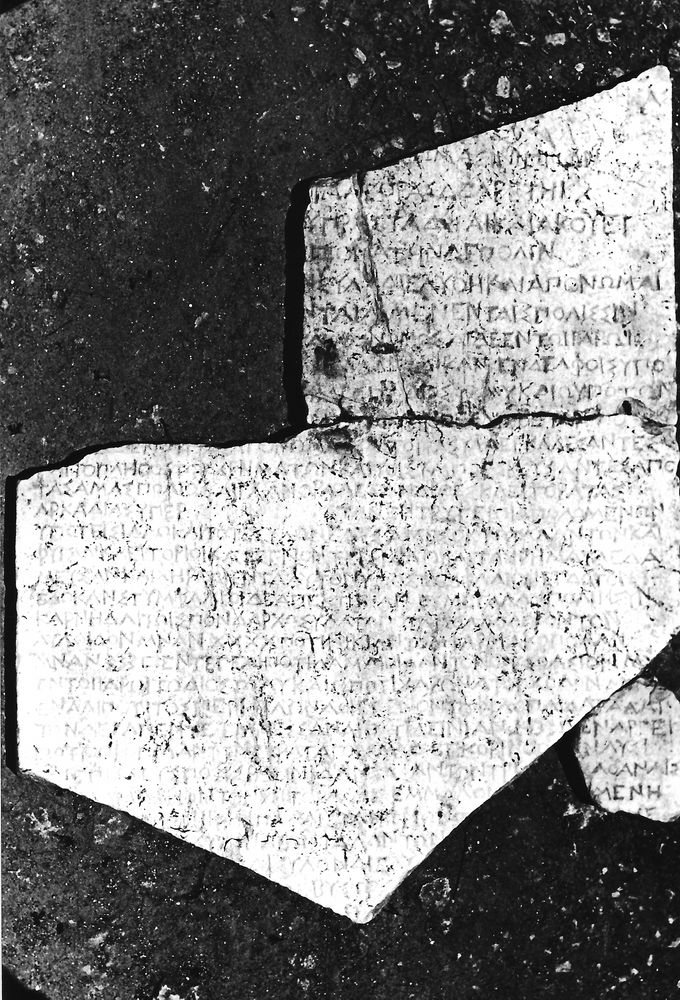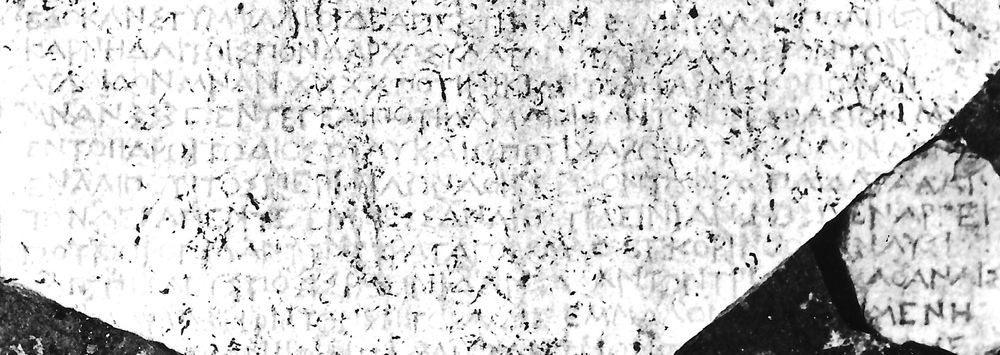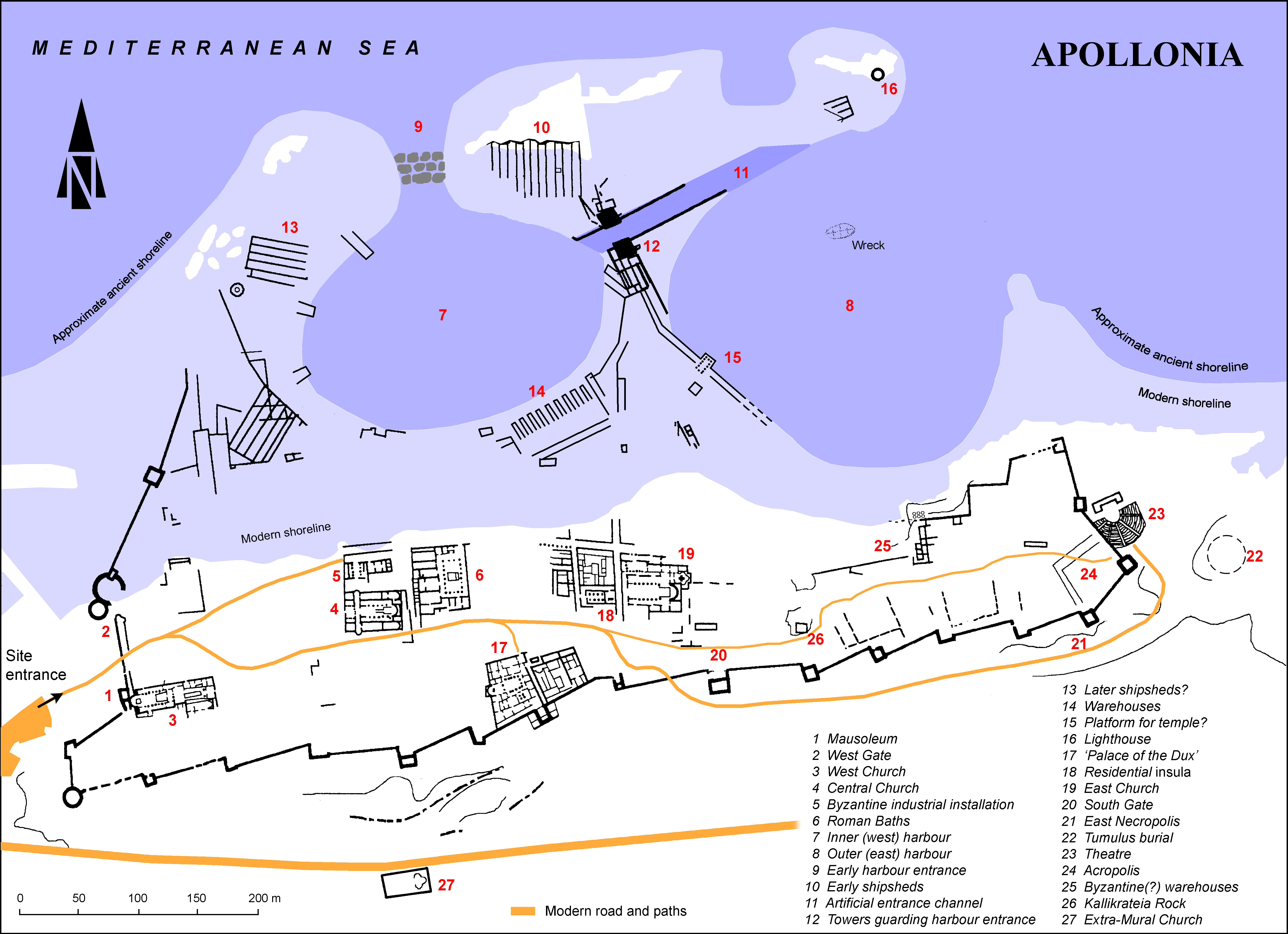EpiDoc XML:
IGCyr0971002
Trismegistos ID:
738485
Source description
Support: Seven fragments of a white marble panel, thicker at left than at right, with a moulding (now lost) above;
six fragments are joining, forming fragment a
(w: 0.387 × h: 0.49 × d: 0.025 at left, 0.015 at right), which itself had lost the upper left angle before the publication);
a seventh non-joining fragment is b
(w: 0.07 × h: 0.116 × d: 0.017);
the total amounts approximately to the measures found in Oliverio's papers (w: 0.4 × h: 0.65 × d: 0.018).
Layout: Inscribed on front face with six lines of verse (GVCyr0332),
immediately followed by the present text.
Letters: 0.005 to 0.009; dissymmetrical nu, slanting mu and sigma, middle-size omicron.
Date: Between 320 and 310 BC (Rosamilia) (lettering, prosopography, textual context).
Findspot: Probably the whole, but at least five fragments of part a were found by G. Oliverio in 1929 at
Cyrene ➚:
Sanctuary of Apollo, in the Eastern part of lower terrace, so-called
Agora of the Gods (see commentary).
One small fragment, adjacent to a, is said to have been found in 1956 by R.G. Goodchild in the
Port of Cyrene, later Apollonia:
Apollonia seashore.Fragment b was possibly gathered in
Cyrenaica during World War II by a member of the Polish Independant Carpathian Rifle Brigade.
Place of origin: Cyrene ➚:
Sanctuary of Apollo.
Last recorded location: Cyrene MuseumCracow Archaeological Museum, 535, MAK/AS/2401.
Fr. Chamoux in 1946 saw only the largest part of fragment a (from line 6 on) and in 1947 the same fragment recomposed in its
actual condition in
Shahat:
Cyrene Museum.
G. Pugliese Carratelli saw in 1960 the main fragment a recomposed at the same place.
D. Morelli saw the small fragment adjacent to a in 1960 at Sūsah:
Apollonia Museum.
C. Dobias-Lalou and A. Laronde observed in 1976 both the Apollonia small fragment and the main a fragment from Cyrene and
were able to check their belonging together.
C. Dobias-Lalou saw again in 2010 the fragment a, pieced together with the small fragment from Apollonia, in
Shahat: Cyrene Museum.
P. Nowakowski saw the fragment b in 2012 at
Cracow: Cracow Archaeological Museum.
Text constituted from: Transcription from stone and Nowakowski supplementary publication (CDL).
Bibliography
SECir, 103 (photo), and Daux 1963, whence SEG, 20.716; Dobias-Lalou – Laronde 1977 added to fragment a the small fragment previously published as SECir, 207 (whence Reynolds 1976, 55); also Bousquet 1978, whence SEG, 27.1194; Bravo 1980, pp. 741-742 and pp. 918-926, whence SEG, 30.1783; Dobias-Lalou 2000, pp. 187-188; Nowakowski 2013, published fragment b, whence SEG, 65.2027, SEG, 65.2028; IGCyr 097100 ➚.
Cf. Anti 1929, p. 429; Oliverio 1932-1933, p. 102; Pugliese Carratelli – Oliverio 1961, p. 3; Garlan 1965; Peek 1972, p. 8; Masson 1975, p. 713; Laronde 1987, pp. 120-121, 149-60, 252; Charneux, BE, 1988.594, and Moretti 1986-1988, pp. 321-322, whence SEG, 38.1879 and SEG, 38.1881; P.M. Fraser in McKechnie 1989, pp. 117-118, with 137 footnote 146, whence SEG, 39.1717; Gasperini 1996, whence SEG, 46.2186; Lazzarini 1996, p. 184, whence SEG, 46.2198; Zimmermann 1996, whence SEG, 46.2330; Łajtar 1999, p. 163, n. 130; Dobias-Lalou 2003, whence SEG, 53.2029; Laronde – Lefèvre 2009, whence SEG, 59.1910; Rosamilia 2023, pp. 203-205 (context, date), pp. 248-251, number 7, ll.7-42 (text).
Text
Interpretive
a
(preceded on the stone by GVCyr0332)
[Ὅσσα κατὰ τῶν πολιατᾶ]ν σῦλ[α] διελύ⸢θ⸣η καὶ ἀπονωμαὶ
[ἀπέδοθεν, αἳ φυλάσσο]νται α[ἱ] μὲν ἐν ταῖς πόλισσιν (vac. 2)
ὑπὸ τῶν δαμιεργῶν κατὰ τὸς νόμος, αἱ δὲ ἐν τῶι ἱαρῶι (vac. 2)
τῶ Διὸς τῶ Ὀλυμπίω ὑπὸ τῶ̣ν Ἑλλανοδικᾶν, ἐν Δελφοῖς ὑπὸ
5τῶν Ἀμφικτυόνων, ἐν τῶι ἱαρῶι τῶ Διὸς τῶ Λυκαίω ὑπὸ τῶν
ἱαρομναμόνων, ἐν Ἀθάν̣αις ὑ̣π[ὸ] τῶν θε̣σμοθετᾶν· ποτ̣[ε?-]
[γράφεν?] δ̣ὲ π̣οτ̣ὶ̣ [τ]ὰς ἀπονωμὰς καὶ τοὶ τὰ σῦλα ἐγκαλέσαντες
[κ]αὶ τὸ πλῆθος τῶγ χρημάτων καὶ τοὶ συμπρεσβεύσαντες ἀπὸ
τᾶς ἁμᾶς πόλιος· Αἰγλάνωρ Ἀλεξάνδρω ἐς Κλείτορα τᾶς (vac. 3)
10Ἀρκαδίας ὑπὲρ (vac. 8) τῶν ἐν Τρυγείωι ἀπολομένων
ὑπὸ Τεισιλάω, καὶ τό τε σῦλον ἐλύσαμες ὀκτὼ ταλάντων καὶ
φυγὰν Κλειτόριοι κατέγνον Τεισιλάω καὶ τὰ χρήματα ἐδά-
μευσαν καὶ χηρ[ω]θ̣έντα αὐτὸν ὑπὸ Στυμφαλίων ἔγδοτον (vac. 2)
ἔδωκαν, Στυμφάλιοι δὲ ἀπέκτη̣ναν· ἐς Mεγάλαν Πόλιν σὺν
15Καρνήδαι τῶι Σπονδάρχω σῦλα τὰ ποτ’Ἀπολλόδωρον τὸν (vac. 3)
αὐλωιδὸν μνᾶν Χ Χ Χ Χ, ποτὶ Νικίαν τὸμ φαρμακοπώλαν (vac. 3)
μνᾶν 𐅠 𐅠 𐅠 𐅝· ἐν Τεγέαι ποτὶ Δαμαιθίδαν τὸν Ὀρεσθάσιον μ(νᾶν) (vac. 2) Χ·
ἐν τῶι ἱαρῶι τῶ Διὸς τῶ Λυκαίω ποτί Χάρωνα τὸγ χωλὸν μ(νᾶν) Χ·
ἐν Ἄλι ποτὶ τὸς περὶ Φ̣ίλωνα οἳ ἐ̣γένοντο Φιλόπαιδα τ̣αλάν-
20των δέκα πέντε· ἐμ Μεσσάναι πο̣τὶ Δεινίαν μ(νᾶν) 𐅠 𐅠 𐅝· ἐν Ἄργει
ποτὶ Θωροπίδαν τ̣ὸν [στ]ραταγὸν μ(νᾶν) 𐅝· ἐγ Κορίνθωι̣ [σὺ]ν Λύσι
τῶι Ἐπικλεῦς ποτὶ Σιμωνίδαν τ̣αλάντων τρι[ῶν]· [ἐν] Ἀθάναις
[ποτὶ] Δαμάτριον τὸν ῥήτορα μ(νᾶν) 𐅝· ἐμ Μάλωι [ποτὶ ...]μένη
[τὸν ὀλυμ]πιονίκα̣ν παλαιστὰν τριῶν τ[αλάντων]· [ἐν ..]Χ̣ε
25[c. 5 ποτ' Αἰ]σ̣χύ[λο]ν δυῶν ταλάντων [---]
[---]ΛΙ σῦλον διελύθ̣[η ---]
[--- Λ]εβυστρα[τ ---]
[--- δι]ε̣λύθ̣[η ---]
[------] b
[------]
(vac. 1 line)
[--- ποτὶ Πε]λλανῆς
[---] ευς καὶ (vac. 2?)
[--- τ]ὸ̣ν Ἀμφισσῆ
[--- τ]α̣λάντων
5[---] μ(νᾶν) 𐅠 Ζ 𐅃 (vac. 2?)
[--- μ(νᾶν)] 𐅠 > > > 𐅃 – – –
[---]ΥΠΟ(vac. 1)
[------] -
a.1 ⸢θ⸣ lapis ο (sic) | a.24 χ vel υ
Diplomatic
a
(preceded on the stone by GVCyr0332)
[..................]ΝΣΥΛ[.]ΔΙΕΛΥΟΗΚΑΙΑΠΟΝΩΜΑΙ
[.................]ΝΤΑΙΑ[.]ΜΕΝΕΝΤΑΙΣΠΟΛΙΣΣΙΝ
ΥΠΟΤΩΝΔΑΜΙΕΡΓΩΝΚΑΤΑΤΟΣΝΟΜΟΣΑΙΔΕΕΝΤΩΙΙΑΡΩΙ
ΤΩΔΙΟΣΤΩΟΛΥΜΠΙΩΥΠΟΤ.ΝΕΛΛΑΝΟΔΙΚΑΝΕΝΔΕΛΦΟΙΣΥΠΟ
5ΤΩΝΑΜΦΙΚΤΥΟΝΩΝΕΝΤΩΙΙΑΡΩΙΤΩΔΙΟΣΤΩΛΥΚΑΙΩΥΠΟΤΩΝ
ΙΑΡΟΜΝΑΜΟΝΩΝΕΝΑΘΑ.ΑΙΣ.Π[.]ΤΩΝΘ.ΣΜΟΘΕΤΑΝΠΟ.[.-]
[......].Ε.Ο..[.]ΑΣΑΠΟΝΩΜΑΣΚΑΙΤΟΙΤΑΣΥΛΑΕΓΚΑΛΕΣΑΝΤΕΣ
[.]ΑΙΤΟΠΛΗΘΟΣΤΩΓΧΡΗΜΑΤΩΝΚΑΙΤΟΙΣΥΜΠΡΕΣΒΕΥΣΑΝΤΕΣΑΠΟ
ΤΑΣΑΜΑΣΠΟΛΙΟΣΑΙΓΛΑΝΩΡΑΛΕΞΑΝΔΡΩΕΣΚΛΕΙΤΟΡΑΤΑΣ
10ΑΡΚΑΔΙΑΣΥΠΕΡ ΤΩΝΕΝΤΡΥΓΕΙΩΙΑΠΟΛΟΜΕΝΩΝ
ΥΠΟΤΕΙΣΙΛΑΩΚΑΙΤΟΤΕΣΥΛΟΝΕΛΥΣΑΜΕΣΟΚΤΩΤΑΛΑΝΤΩΝΚΑΙ
ΦΥΓΑΝΚΛΕΙΤΟΡΙΟΙΚΑΤΕΓΝΟΝΤΕΙΣΙΛΑΩΚΑΙΤΑΧΡΗΜΑΤΑΕΔΑ
ΜΕΥΣΑΝΚΑΙΧΗΡ[.].ΕΝΤΑΑΥΤΟΝΥΠΟΣΤΥΜΦΑΛΙΩΝΕΓΔΟΤΟΝ
ΕΔΩΚΑΝΣΤΥΜΦΑΛΙΟΙΔΕΑΠΕΚΤ.ΝΑΝΕΣMΕΓΑΛΑΝΠΟΛΙΝΣΥΝ
15ΚΑΡΝΗΔΑΙΤΩΙΣΠΟΝΔΑΡΧΩΣΥΛΑΤΑΠΟΤΑΠΟΛΛΟΔΩΡΟΝΤΟΝ
ΑΥΛΩΙΔΟΝΜΝΑΝ Χ Χ Χ Χ ΠΟΤΙΝΙΚΙΑΝΤΟΜΦΑΡΜΑΚΟΠΩΛΑΝ
ΜΝΑΝ 𐅠 𐅠 𐅠 𐅝 ΕΝΤΕΓΕΑΙΠΟΤΙΔΑΜΑΙΘΙΔΑΝΤΟΝΟΡΕΣΘΑΣΙΟΝΜ .
ΕΝΤΩΙΙΑΡΩΙΤΩΔΙΟΣΤΩΛΥΚΑΙΩΠΟΤΙΧΑΡΩΝΑΤΟΓΧΩΛΟΝΜ.
ΕΝΑΛΙΠΟΤΙΤΟΣΠΕΡΙ.ΙΛΩΝΑΟΙ.ΓΕΝΟΝΤΟΦΙΛΟΠΑΙΔΑ.ΑΛΑΝ
20ΤΩΝΔΕΚΑΠΕΝΤΕΕΜΜΕΣΣΑΝΑΙΠ.ΤΙΔΕΙΝΙΑΝΜ 𐅠 𐅠 𐅝 ΕΝΑΡΓΕΙ
ΠΟΤΙΘΩΡΟΠΙΔΑΝ.ΟΝ[..]ΡΑΤΑΓΟΝΜ 𐅝 ΕΓΚΟΡΙΝΘΩ.[..]ΝΛΥΣΙ
ΤΩΙΕΠΙΚΛΕΥΣΠΟΤΙΣΙΜΩΝΙΔΑΝ.ΑΛΑΝΤΩΝΤΡΙ[....]ΑΘΑΝΑΙΣ
[....]ΔΑΜΑΤΡΙΟΝΤΟΝΡΗΤΟΡΑΜ.ΕΜΜΑΛΩΙ[....+++]ΜΕΝΗ
[.......]ΠΙΟΝΙΚ.ΝΠΑΛΑΙΣΤΑΝΤΡΙΩΝΤ[.........++].Ε
25[+++++......].ΧΥ[..]ΝΔΥΩΝΤΑΛΑΝΤΩΝ[---]
[---]ΛΙΣΥΛΟΝΔΙΕΛΥ.[.---]
[---.]ΕΒΥΣΤΡΑ[.---]
[---..].ΛΥ.[.---]
[------] b
[------]
vacat
[---......]ΛΛΑΝΗΣ
[---]ΕΥΣΚΑΙ
[---.].ΝΑΜΦΙΣΣΗ
[---.].ΛΑΝΤΩΝ
5[---]Μ 𐅠 Ζ 𐅃
[---..] 𐅠 > > > 𐅃 – – –
[---]ΥΠΟ
[------]
a.1 ⸢θ⸣ lapis ο (sic) | a.24 χ vel υ
Apparatus
a.1: [ὅσσα κατὰ τῶν πολιατᾶ]ν: [c. 18]Ν Laronde – Lefèvre 2009; [---]Ν SECir, Laronde 1987 || ἀπονωμαί Bravo 1980, Dobias-Lalou 2000: ἀπον⸢ο⸣μαί SECir so all other editors
a.2: [ἀπεδόθεν, αἳ φυλάσσο]νται Laronde – Lefèvre 2009: [---φυλάσσο]νται SECir so all editors but Bravo 1980; [ἐτελέσθησαν, αἳ φυλάσσο]νται Bravo 1980; [---καταγράφο]νται Laronde – Lefèvre 2009; [---ἀναγράφο]νται Laronde – Lefèvre 2009; [ἀπεδόθησαν, αἳ τηροῦ]νται Laronde – Lefèvre 2009; [κατεβλήθησαν, αἳ τηροῦ]νται Laronde – Lefèvre 2009; [ἐξετείσθησαν, αἳ τηροῦ]νται Laronde – Lefèvre 2009
a.5: τῶν Ἀμφικτυόνων SECir: τῶν Ἀμφικτυόνων Laronde – Lefèvre 2009; Ἀμφικτιόνων Laronde – Lefèvre 2009
a.6-7: ποτ̣[ε-]|[γράφεν?] Daux 1963: ποτ̣[ιγρά|φονται?] SECir, Bravo 1980; ποτ̣[ε-]|[γράφεν?] Laronde – Lefèvre 2009; ποτ̣[ε-]|[τέθεν?] Laronde – Lefèvre 2009
a.7: ἀπονωμάς Bravo 1980, Dobias-Lalou 2000: ἀπον⸢ο⸣μάς SECir so by all editors
a.8: τῶγ χρημάτων καὶ τοὶ συμπρεσβεύσαντες SECir: τῶγ χρημάτων · καὶ τοὶ συμπρεσβεύσαντες Chamoux 1953, Laronde 1987
a.8-9: ἀπὸ | τᾶς ἁμᾶς πόλιος · Αἰγλάνωρ SECir: ἀπὸ | τᾶς ἁμᾶς πόλιος Αἰγλάνωρ Chamoux 1953, Laronde 1987
a.13: χηρ[ω]θ̣έντα Laronde 1987: χηρω̣[θ]έντα SECir
a.17: Δαμαιθίδαν Daux 1963: Δαματ̣ρίδαν SECir
a.18: Χ̣ Daux 1963: [.] SECir
a.19: Ἄλι Laronde 1987: Ἆλι SECir, Daux 1963 || Φιλόπαιδα Daux 1963: φιλόπαιδας̣ SECir; φιλόπαιδ⸢ε⸣ς̣ McKechnie 1989 Fraser's reading
a.19-20: τ̣αλάν|των Dobias-Lalou – Laronde 1977: [ταλάν-]|των SECir fragment independently published as SECir, 207
a.21: [σὺ]ν Λύσι Dobias-Lalou – Laronde 1977: ν̣αυσί SECir
a.22: τ̣αλάντων Dobias-Lalou – Laronde 1977: [τ]αλ̣άντων SECir || τρι[ῶν· ἐν] Ἀθάναις Dobias-Lalou – Laronde 1977: [---] Ἀθάναις SECir
a.23: [ποτὶ ...]μένη Dobias-Lalou – Laronde 1977: [---]μένη SECir
a.24: [τὸν ὀλυμ]πιονίκα̣ν Dobias-Lalou – Laronde 1977: [...ὀλυμ]πιονίκα̣ν SECir || τ[αλάντων· ἐν ..]Χ̣ε Dobias-Lalou – Laronde 1977: τ[αλάντων ---] SECir [---]ΧΕ read in SECir, 207
a.24-25: Χ̣ε | [c. 5] : [ἐ]ν̣ ̣Ε̣ὐε|[σπερίσσι] Bousquet 1978
a.25: [ποτ' Αἰ]σ̣χύ[λο]ν Bousquet 1978, Bravo 1980, IGCyr, Rosamilia 2023: ΣΧΥ[ρ]ΟΝ Daux 1963 ἱσχυρόν adjective or personal name; [c. 10]ΣΧΥ[..]Ν SECir
a.27: [Λ]εβυστρα[τ] Masson 1975: [Λ]ιβυστρα[τ] Peek 1972; ΕΒΥΣΤΡΑ[---] SECir
a.28: [--- δι]ε̣λύθ̣[η ---] Daux 1963: [---]+ΛΥΟ[---] SECir followed by all editors
b.0a: (vac. 1 line) no end of written line has a space of more than 3 characters left at line's end: [---](vac. 6?) Nowakowski 2013
b.1: [ποτὶ Πε]λλανῆς IGCyr: [.. ? ..Πε]λλανῆς Nowakowski 2013, Rosamilia 2023
French translation
a) [Voici tous] les droits de représailles [contre les citoyens] qui ont été liquidés et les restitutions qui [ont été réglées,
lesquelles sont archivées] les unes dans les cités par les démiurges conformément aux lois, les autres dans le sanctuaire
de Zeus Olympien par les Hellanodiques, à Delphes par les Amphictions, dans le sanctuaire de Zeus Lykaios par les hiaromnamons,
à Athènes par les thesmothètes; [ont été inscrits], outre les restitutions, (scil. les noms de) ceux qui ont invoqué des droits de représailles et le montant des sommes, ainsi que (scil. les noms de) ceux qui ont participé à l’ambassade de notre cité : Aiglanor fils d’Alexandros, à Kleitôr (10) d’Arcadie au
sujet de ceux qui périrent à Trygeion du fait de Teisilaos : nous avons liquidé le droit de représailles pour un montant de
huit talents, les Kleitoriens prononcèrent une peine de bannissement contre Teisilaos, confisquèrent ses biens et, quand les
Stymphaliens eurent mis la main sur lui, ils le leur livrèrent et les Stymphaliens le mirent à mort; à Mégalopolis avec Karnèdas
fils de Spondarkhos, droits de représailles liquidés envers Apollodôros le joueur d’aulos pour un montant de 4000 mines, envers
Nikias le marchand de drogues pour un montant de 700 mines; à Tégée envers Damaithidas d’Oresthasion pour un montant de 1000
mines; au sanctuaire de Zeus Lykaios envers Kharôn le boiteux pour un montant de 1000 mines; à Elis, envers le cercle de Philôn
dit Philopais pour un montant de 15 talents; (20) à Messène, envers Deinias pour un montant de 500 mines; à Argos envers Thôropidas
le stratège pour un montant de 100 mines; à Corinthe avec Lysis le fils d’Epiklès envers Simônidas pour un montant de 3 talents;
à Athènes envers Dèmètrios l’orateur pour un montant de 100 mines; à Mèlos envers [---]ménès le lutteur olympionique, pour un montant de trois talents; à [---] envers [Ai]skhylos pour un montant de deux talents; [---] le droit de représailles a été liquidé [--- avec?] Lébystratos [---] a été liquidé [---]
b) [--- envers] les gens de Pellène [---] (scil. Untel fils de) [---]ès et (scil. Untel fils d’Untel) [---] (scil. envers) l’homme d’Amphissa [---], pour un montant de [---] talents; [---] (scil. envers Untel pour un montant d’au moins) 255 mines; [---] (scil. envers Untel pour un montant d’au moins) 238 mines; [---]
English translation
a) [These are all] the reprisal rights [against citizens] that were extinguished and the restitutions that [were settled,
all of which are filed], some of them in the cities by the damiergoi in compliance with the laws, the others in the sanctuary
of Zeus Olympios by the Hellanodikai, at Delphi by the Amphictyons, in the sanctuary of Zeus Lykaios by the hiaromnamones, at Athens by the thesmothetai; [were inscribed], beside the restitutions, (scil. the names of) those who invoked reprisal rights and the amounts of money, as well as (scil. the names of) those who took part in the mission sent by our city: Aiglanor son of Alexandros, to Kleitor (10) of Arcadia
about those who perished at Trygeion because of Teisilaos: we estinguished the reprisal right for an amount of eight talents,
the Kleitorians passed sentence of banishment against Teisilaos, confiscated his goods and, when the Stymphalians had seized
him, they handed him over and the Stymphalians killed him; to Megalopolis with Karnedas son of Spondarchos, reprisal rights
estinguished toward Apollodoros the aulos-player for an amount of 4000 mines, toward Nikias the drug-seller for an amount
of 700 mines; at Tegea toward Damaithidas from Oresthasion for an amount of 1000 mines; in the sanctuary of Zeus Lykaios toward
Charon the lame for an amount of 1000 mines; at Elis, toward the group of Philon so-called Philopais for an amount of 15 talents;
(20) at Messena, toward Deinias for an amount of 500 mines; at Argos toward Thoropidas the general for an amount of 100 mines;
at Corinth with Lysis son of Epikles toward Simonidas for an amount of 3 talents; at Athens toward Demetrios the orator for
an amount of 100 mines; at Melos toward [---]menes the wrestler who winned at the Olympian games, for an amount of three talents; at [---] toward [Ai]schylos for an amount of two talents; [---] the reprisal right has been extinguished [--- with?] Lebystratos [---] was extinguished [---]
b) [--- toward] the Pellenians [---] (scil. So-and-so son of) [---]es and (scil. So-and-so son of So-and-so) [---] (scil. toward) the Amphissaean [---] for an amount of [---] talents; [---] (scil. toward So-and-so for an amount of at least) 255 mines; [---] (scil. toward So-and-so for an amount of at least) 238 mines; [---]
Italian translation
a) [Questi sono tutti] i diritti di rappresaglia [contro cittadini] che sono stati liquidati e le restituzioni che [sono
state regolate, le quali sono archiviate] alcune nelle città dai damiergoi in accordo con le leggi, le altre nel santuario
di Zeus Olympios dagli Hellanodikai, a Delfi dagli Anfizioni, nel santuario di Zeus Lykaios dagli hiaromnamones, ad Atene dai tesmoteti; [sono stati iscritti], oltre alle restituzioni, (scil. i nomi di) coloro che hanno invocato dei diritti di rappresaglia e l'ammontare delle somme, come pure (scil. i nomi di) coloro che hanno preso parte all'ambasceria inviata dalla nostra città: Aiglanor figlio di Alexandros, a Kleitor
(10) in Arcadia a proposito di coloro che morirono a Trygeion a causa di Teisilaos: abbiamo liquidato il diritto di rappresaglia
per l'ammontare di 8 talenti, i cittadini di Kleitor hanno condannato all'esilio Teisilaos, hanno confiscato i suoi beni e,
quando i cittadini di Stymphalos l'hanno catturato, l'hanno consegnato a loro e i cittadini di Stymphalos l'hanno ucciso;
a Megalopolis con Karnedas figlio di Spondarchos, diritti di rappresaglia liquidati nei confronti di Apollodoros il suonatore
di aulo per l'ammontare di 4000 mine, nei confronti di Nikias il venditore di droghe medicinali per l'ammontare di 700 mine;
a Tegea nei confronti di Damaithidas da Oresthasion per l'ammontare di 1000 mine; nel santuario di Zeus Lykaios nei confronti
di Charon lo zoppo per l'ammontare di 1000 mine; a Elide, nei confronti del gruppo di Philon detto Philopais per l'ammontare
di 15 talenti; (20) a Messene, nei confronti di Deinias per l'ammontare di 500 mine; ad Argo nei confronti di Thoropidas lo
stratego per l'ammontare di 100 mine; a Corinto con Lysis figlio di Epikles nei confronti di Simonidas per l'ammontare di
3 talenti; ad Atene nei confronti di Demetrios l'oratore per l'ammontare di 100 mine; a Melos nei confronti di [---]menes il lottatore che vinse agli agoni olimpici, per l'ammontare di tre talenti; a [---] nei confronti di [Ai]schylos per l'ammontare di due talenti; [---] il diritto di rappresaglia è stato liquidato [--- con?] Lebystratos [---] è stato liquidato [---]
b) [--- nei confronti] dei cittadini di Pella [---] (scil. il tale figlio di) [---]es e (scil. il tale figlio del tale) [---] (scil. nei confronti) dei cittadini di Anfissa [---], per l'ammontare di [---] talenti; [---] (scil. nei confronti del tale per l'ammontare di almeno) 255 mine; [---] (scil. nei confronti del tale per l'ammontare di almeno) 238 mines; [---]



